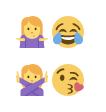Emoji Style Guide
 While the emoji may seem new (especially since no one really used them until the 20-teens), it’s a tale as old as time. Like fashion, communication is a never-ending cycle. Right now we’re seeing the return of low-rise jeans à la Paris Hilton, and I’m sure that soon enough we’ll all be wearing gauchos and carrying purses made out of Kool-Aid pouches. At least I really, really hope we will be. Society loves to recycle trends, but we seem to have brought back more than just styles. The modern world is throwing it back to a language that is downright Paleolithic, a language that even a toddler could name: the emoji. But what are the rules to using the emoji, particularly in digital marketing? Find out in our Emoji Style Guide!
While the emoji may seem new (especially since no one really used them until the 20-teens), it’s a tale as old as time. Like fashion, communication is a never-ending cycle. Right now we’re seeing the return of low-rise jeans à la Paris Hilton, and I’m sure that soon enough we’ll all be wearing gauchos and carrying purses made out of Kool-Aid pouches. At least I really, really hope we will be. Society loves to recycle trends, but we seem to have brought back more than just styles. The modern world is throwing it back to a language that is downright Paleolithic, a language that even a toddler could name: the emoji. But what are the rules to using the emoji, particularly in digital marketing? Find out in our Emoji Style Guide!
What Is an Emoji?
In the year 1982, Internet users began combining punctuation marks to create pictorial representations of facial expressions. This gave us the smiley-face : ) and the frowny face : ( so that the person on the receiving end of a text communication could understand the emotion behind the message. These representations, known as emoticons, grew to include winks ; ), tongues out : P, and even shrugs ¯\_(ツ)_/¯.
In 1995, we were given the emoji, the lovechild of hieroglyphics and emoticons. These 12-by-12 pixel images were adopted by Unicode Consortium in 2010, meaning any phone or operating system following Unicode could access these images. Generally speaking, emoji is more universally understood than any formal alphabet.
How & When Do You Use Emojis?
Ask, no more. Presenting:
The Online Optimism Style Guide to Emoji Usage
Emojis end a sentence.
We love dogs at Online Optimism 🐶
not
We love dogs 🐶 at Online Optimism.
Emojis replace periods but go after exclamation points and question marks.
We love dogs at Online Optimism! 🐶
not
We love dogs at Online Optimism 🐶!
and similarly
Does Online Optimism love dogs? 🐶
not
Does Online Optimism love dogs 🐶?
In marketing, emojis should be used to emphasize a word, not replace it.
Futures so bright, they have to wear sunglasses 😎 Congratulations JP & Morgan on your ADDYs wins! pic.twitter.com/WBKE3mbc4c
— Online Optimism (@onlineoptimism) March 1, 2018
Of course, some rules are meant to be broken. Using a heart emoji in place of the word “love” is common enough that audiences of all ages will know that “We 💚 dogs!” and “We love dogs!” mean the same thing.
Another time this rule can be broken is if it matches your brand voice or personality. For example, Las Vegas hockey team the Vegas Golden Knights uses 🌸 when tweeting about goalie Marc-Andre Fleury.
Get it? Because in French, “fleur” means “flower.”
Happy 🌸
Happy us pic.twitter.com/GAzlfKSYlK
— Vegas Golden Knights (@GoldenKnights) May 21, 2018
Emojis read with linear time and action, like painting a picture.
The rocket has to be traveling toward the moon:
I’m on a rocket to the moon 🚀🌕
And emotion always comes before the action or signal.
Let the reader know how to feel about the content. For example, you can give it some facial expression:
That was cool 😎🤙
says something different than
That was cool 🙄🤙
. . . With the exception of a person emoji.
When using a person, like a shrug or the hair flip, that emoji can come before the standard emotion emojis:

Emoji Usage by Network
Just as you would advertise differently across different mediums and networks, you’ll want to change your emoji strategy wherever you go.
Emoji usage on Facebook depends on your brand’s voice. If your brand is aiming to be fun and fresh—or reach younger generations—emojis are both effective communicators and attention grabbers. However, no post should feature more emojis than words.

Twitter loves emojis. They’re a compromise when trying to fit information into a limited character count, and they’re fun for jazzing things up with a quote tweet rather than just giving the simple RT.
🖤⚜🖤⚜🖤⚜🖤⚜ https://t.co/P2uI2I4AdB
— Online Optimism (@onlineoptimism) March 13, 2018
The good news with ads on Twitter is that they appear naturally in the feed, so emojis are as good as gold for making sponsored content look more organic.
Instagram loves emojis even more. As an already visual platform, it’s a natural place for using a pictorial language. Of course, exclusively using emojis isn’t always the best idea.
Just like on Twitter, using emojis in Instagram ads is totally normal, thanks to sponsored content appearing in the feed with posts and hashtags users follow.
And finally, known as the most professional of networking platforms, LinkedIn is a place where you should just say 🙅 to emojis.
